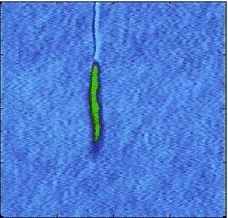Rechercher
Accueil > La Recherche > Axes & Equipes > Matière Molle & Verres > Equipe : Physique des Verres > Thème : Mécanismes d’endommagement des verres à l’échelle nanométrique
Environmental condition at crack tips in silica glass
publié le
Involved researchers : M. Ciccotti, M. George, A. Grimaldi, G. Pallares
(Collaboration L. Wondraczek, E. Charlaix)
The environmental condition at the crack tip has a determinant effect on the propagation processes. In particular, the development of AFM phase imaging techniques has allowed to demonstrate the presence of a capillary condensed phase in the most confined portion of the crack tip cavity. This phase was shown to be in equilibrium with regard to the external atmosphere and to provide important information on the chemical aging of the crack tip environment. The presence of this condensate phase and the evolution of its composition are very promising to obtain a quantitative model of the slow crack propagation kinetics as a function of the glass composition. The efforts have then been concentrated to model the chemical effect of the capillary condensation on the rate of the stress-corrosion reactions and of the ion exchange (leaching) processes, as well as the mechanical effect induced by both the capillary forces and the ion migration at the crack tip.

Recent publication : Phys. Rev. Lett. 100, 165505 (2008)








